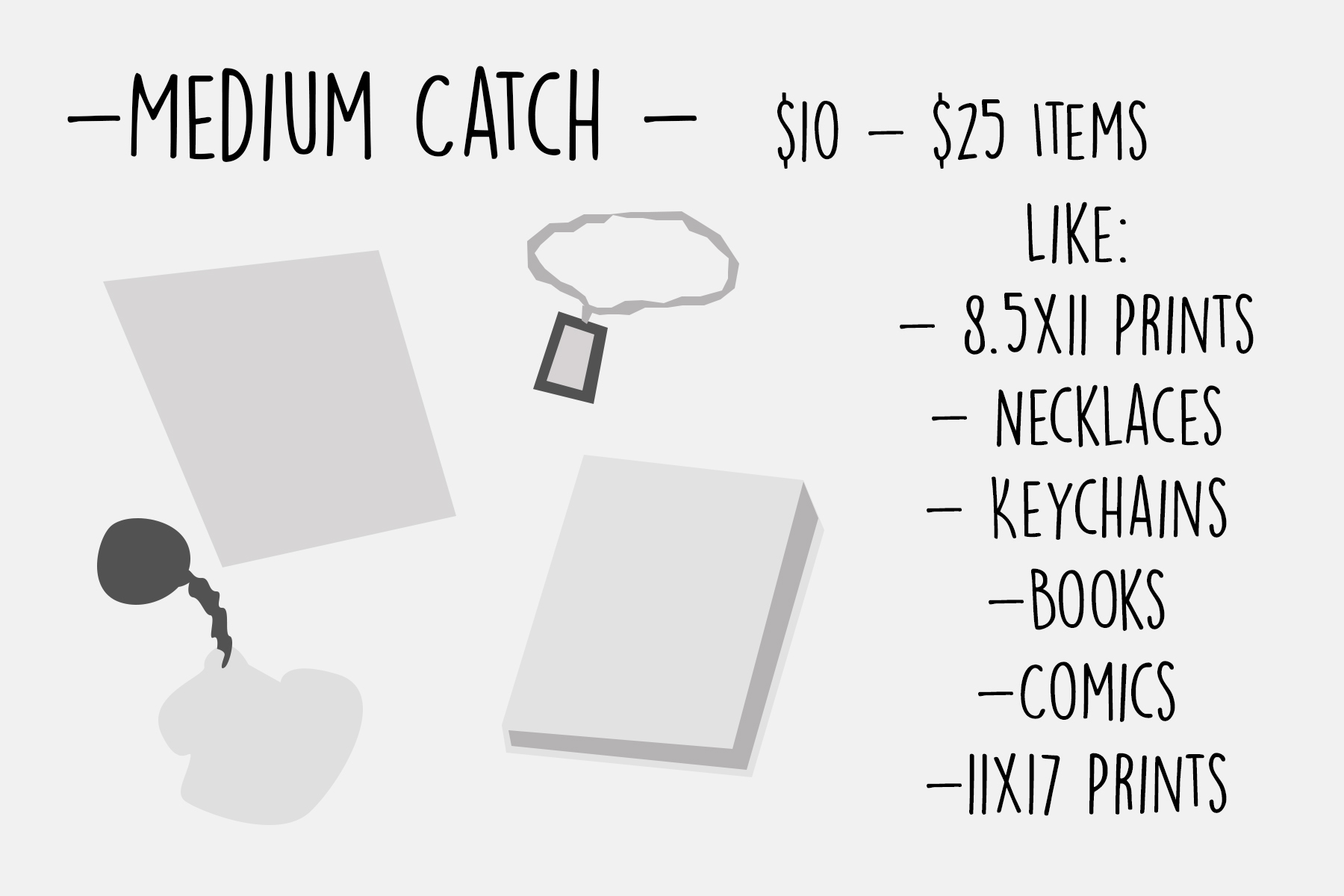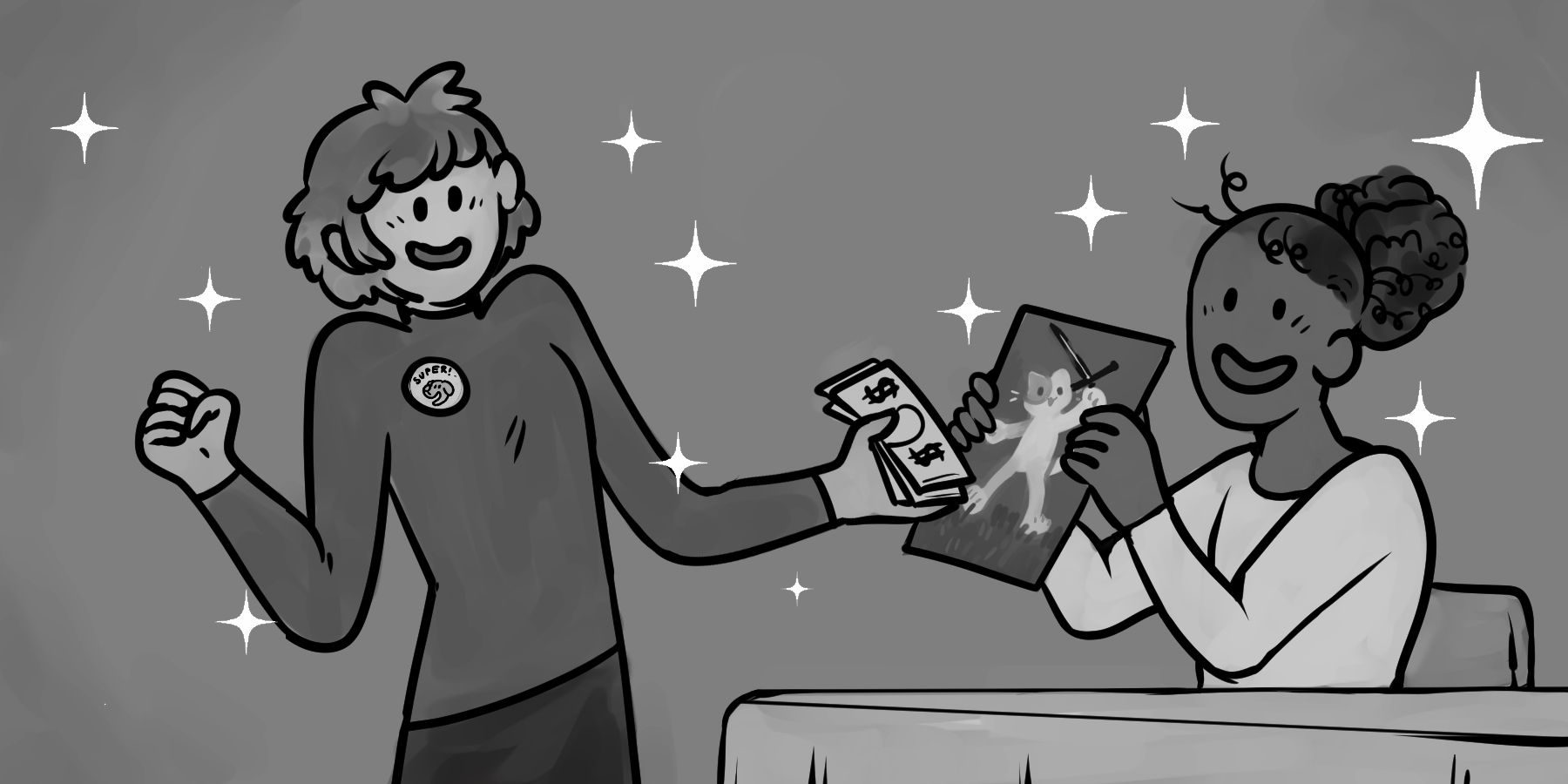Hello All!
This is the first of (hopefully!) a couple different articles about how to run a booth at a comic convention or other event that’s set up trade-show style. I’ll be covering a lot but with Harvest coming up and several people wanting to do other shows, I wanted to talk a little bit about tabling. There are several different parts to running a table, from how you set up your display to what merchandise you are selling. Today I’m going to go over two of the major parts of running a table at a convention; display and merchandise.
DISPLAY
Artist- Bri Crozier
Display is one of the most important parts of selling at a convention. It’s the first thing your customers are going to see! It needs to be pretty eye catching, as there are lots of other things fighting for people’s attention. First, always bring a tablecloth! Some shows provide them but it’s always a good idea to bring at least one, in case they don’t. If you don’t use it for your table , you could use it to hide your assorted boxes and supplies.
Next, you want to think about height! If you’re participating in a convention that is held in a large convention hall, people are typically walking through the hall looking up. In shows with lower ceilings (like Harvest), people are looking more at eye level. Either way, you want to have items upright and visible! If your work is flat on the table, no one can see it! And if no one can see it, no one will buy it. You want to have a variety of work upright and visible so that it catches as many people’s eyes as possible. One way to do this is simply to purchase wire picture stands at Michaels or Hobby Lobby and place your prints on them.
You should also think about what is behind you. You can gain more height and visibility with a banner of some sort, many artists use a photo backdrop stand that they attach prints too, but another way to do this is to use PVC piping and create your own. PVC doesn’t always look as nice, but it can be fairly cheap. What ever you decide on, make sure it’s easy to put up and take apart. If you are tableing by yourself, you want to make sure everything is as easy to move as possible. Another thing to think about it that most shows have regulations on how tall banners can be, so always check the conventions display rules.
Artist - Bri Crozier
You can also purchase a pop up banner which can be good for smaller venues or sharing tables as it doesn’t take up much space. Most tables have very little room behind them, so having a display that doesn’t take up too much space is incredibly important.
Artist - Arlan Engin
Another option is to use grid wire shelving. Lots of artists use these in lieu of a banner and it works perfectly for them. You can attach prints to it and also use the insides as a storage space. One thing to consider with this however is that sometimes using grid wire can block visibility of your neighbor, which is not cool. If you choose to use grid wire, make sure to never put your work on the sides facing your neighbors, as this is not only incredibly rude, but many shows have rules against it. Instead, it’s typically polite to let your neighbor attach items to the grid wire facing them, as this gives them more height in return for you blocking them a little.
Artist - Arlan Engin
Now that we have an idea of how display our work, it’s time to consider how you are going to display your merchandise. It’s always best to have examples of your merch out on your table. Many times, even if you have signs up with what you are offering, people overlook these. Try to have 1-2 examples of each of your items out. For items like buttons, you can either have them in a little basket/box that people can pick through, or you can have them on a display. There are pros and cons to either option, as if people can dig through the box, they are often more likely to buy the item once they are holding it, but if you have them on a display, things are less likely to be stolen. For flat items like prints, it’s best to just have them in a little portfolio book that people can flip through.
Artist - Arlan Engin
MERCHANDISE
I like to seperate types of merch into 3 categories: Small Fry, Medium Catch, and Big Fish.
Small Fry are little items under $10, these are things like, buttons, stickers, bookmarks, mini prints, and little zines. These are items you have for people who don’t have as much money to spend, like kids and teens, or people who prefer smaller items.
Artist - Bri Crozier
Medium Catch are items from $10-$25, and these can be things like 8.5x11 prints, 11x17 prints, necklaces, keychains, and books and comics. These are your regular money makers that everyone might want.
Artist - Bri Crozier
Big Fish are larger or fancier items $25+, and these can be things like t-shirts, wall posters/scrolls, figurines, originals, and collectors items. These are the things you don’t sell as often, but are always good to have because these are definitely items people are interested in and will want to purchase.
Artist - Bri Crozier
You want to have a good mix of the three, with most of your items (3-5) falling into the Medium Catch category, 1-3 Small Fry, and 1-3 Big Fish. A good tip is to make sure you don’t have to much cross over between the three in terms of design, as if someone is about to by a print, but ends up buying the same design on a button instead, that kind of sucks. Obviously, if you are selling originals, this isn’t possible, but originals hold their own appeal, and most of the time people who want them will be willing to pay extra for the original piece.
Artist - Arlan Engin
A quick note about taxes.
When selling items, no matter what people say, you ALWAYS have to pay sales tax. Even if you sell only one thing, you are technically required to pay sales tax. Most of the time shows will provide you with the sale tax of the area, which you can use to calculate it out. Often times people will find the percentage based on their overall sales, but some people will make spreadsheets and do it based on the individual sales. Both methods work. When you do credit card sales, you typically want to charge tax so that you aren’t hit with both the card reading fee as well as the tax.
Artist - Arlan Engin
In all, tabling is mostly about know what is going to catch people’s attention. You want merchandise that you and others love, and you want a display that shows it off. It’s always heartbreaking to be at a show and know that your display just isn’t working. Before you go to the show, try setting up your display on a table or space of the same size to make sure you can fit everything you need/want on the table.
That's all I have for today! I hope this was helpful to you guys, and feel free to leave a comment if you have any questions or topics you want me to cover in the future! Have a fantastic day!
Bri
Illustrations by Arlan Engin and Bri Crozier









